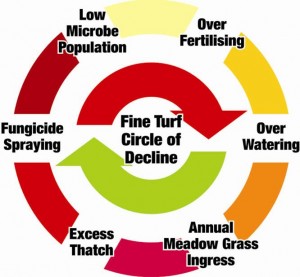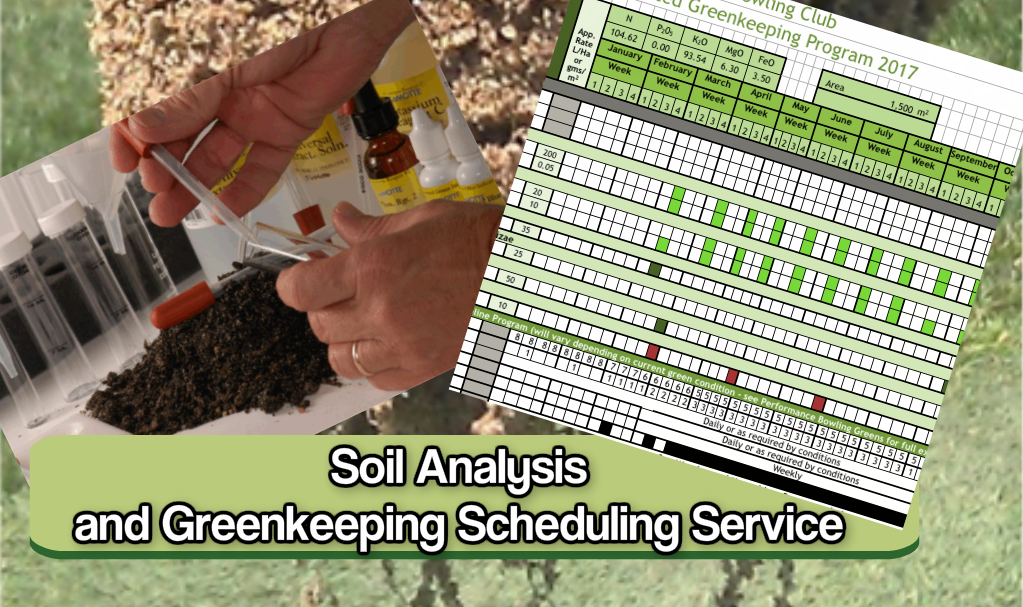The Chemistry, Biology and Physics of Fine Turf Greens
For greenkeepers, the importance of understanding the ecology of greens can’t be over-stated, and to do that, we need to have a basic understanding of the science that goes on all around us every day.
Management of greens for bowls or golf or indeed the management of any sport or recreational area where fine, perennial grass is desirable, relies on us understanding at least the basics of science.
Now, those basics are generally split up into the three biggies we are taught at school, Chemistry, Biology and Physics. And, indeed, as greenkeepers we need to have a grasp of the Physical, Chemical and Biological goings on in our soil otherwise we might just as well be taking a stab in the dark with any or all of our maintenance practices.
Bringing the 3 biggies back together; thinking about Eco-systems
Having split the soil up into these convenient compartments as we humans like to do, it’s worth remembering that this compartmentalisation of science is ultimately a figment of our human imaginations and that nature doesn’t work like this. Soil microbes don’t know that they are part of the soil biology, and soil Chemistry is very much dependent on, and heavily influenced by both the Biology and Physics of the soil.
None of the organisms or elements in the soil have any idea whatsoever that they are even components of the soil or indeed that they have names that distinguish them from each other for the benefit of our logical brains! Green ecology is best thought of in terms of the whole and that includes outside influences from the wider environment as well as the work we do on the green ourselves.
The fact is that regardless of how clever we humans are becoming, it’s unlikely that we are even close to understanding how eco-systems work, so meddling in them too much is unlikely to yield the results we expect; there are just too many interactions for us to comprehend. It’s enough to know that species’ are inter-dependent and symbiotic in many cases and there are literally thousands of species at work in our greens beyond the 3 or 4 such as Agrostis tenuis, Festuca rubra, Poa annua and Microdochium nivale (bent grass, fescue, annual meadow grass and fusarium disease) we seem to spend all of our waking hours fretting over.
What we do know about eco-systems is that they consist of communities of different organisms and that each of the individual species’ within those communities has a role and a particular niche it prefers to occupy. As greenkeepers, our one and only job is to make sure the collection of conditions (in terms of the Biology, Chemistry and Physics of our soil) add up to create the niche desired by the fine perennial grasses we seek to grow.
Now the Squirrels you’ve been waiting for
As an aside, but still interesting illustration of this, over the last 10 or 15 years, I have noticed in the countryside where I live that we have thriving populations of native red squirrels, hares and foxes. Conversely, there is an almost total absence of rabbits and grey squirrels…I never have any bother with rabbits in my vegetable patch at home and that is quite a remarkable thing in the UK. Also for the first time a few weeks ago, I saw a Pine Marten crossing the road (presumably to get to the chickens on the other side:-) and that was a real surprise.
None of this sparked any lightbulbs in my big human brain (duh!) until I watched Wild Ireland on TV last week and the presenter observed that where Pine Martens are thriving, so too are Red Squirrels. Grey Squirrels meantime have almost disappeared. One hypothesis offered for this is that Red Squirrels and Pine Martens evolved together and that the Reds have inbuilt Pine Marten coping mechanisms that Greys just don’t have. A Grey squirrel is also a bigger meal for a Pine Marten so the combination of these factors probably makes Greys a more attractive proposition for them.
At my place, I’m seeing these connections at work with the presence of Pine Martens and Foxes possibly equalling more Red Squirrels, fewer Greys, no Rabbits and lots of Hares. Also lots of grumpy good lifers and shooting syndicates who keep losing their hens and pheasants to foxes. Of course, hens and pheasants evolved in a totally different environment and along with Rabbits and Grey Squirrels are relatively recently introduced species to these shores. When nature is allowed to take its course without too much human interference, the relationships that have built up and evolved over hundreds if not thousands of generations seem to prevail.
What the squirrels are telling me
Similar dependencies and inter-relationships are at work in our greens. We just have to take a step or two back and think about what it is that keeps our greens being dominated by Poa annua and not Bent and Fescue grasses.
Here’s a fascinating statement from a golf course superintendent friend in the USA, who just happens to follow a program very similar to my Performance Greens Program:
“Just visited a friend with both bent greens and fairways. Due to lack of $$$$ his golf course is still predominantly clean of Poa invasion after 10 years”
Interesting, isn’t it? Due to lack of funds, the greens are still predominantly fine grass after 10 years! What does that suggest?
Well, I think it suggests that due to financially driven low to zero inputs of fungicide, inorganic high salt fertiliser and sand top-dressing, these greens are largely existing in a way that is very similar to a natural grassland. I explained in some detail how natural grasslands evolve in another article, and it seems to me that this is what’s going on here.
The Circle of Decline
When we acidify the soil unnaturally, we create an imbalance in the soil chemistry which locks up nutrients and causes the need for excessive inorganic fertiliser application. Excessive inorganic fertiliser application requires more water to activate it and that leads to reduced pore space in the soil, which leads to anaerobic soil, which leads to reduced microbe populations. Low microbe populations lead to poor soil nutrient release and that means yet more fertiliser is required to force a reaction from the grass.
Reduced microbial activity also leads to excessive thatch build up, which leads to spongy, bumpy turf. Enter sand top-dressing as a futile attempt to level out the bumps, but sand and thatch make mat, which becomes hard, hydrophobic and even more bumpy and uneven. In wet weather this gradually becomes wet and holds water at the surface like a sponge, which leads to disease outbreaks, which of course calls for more fungicide.
Poa annua thrives in a bacteria dominated rootzone and is less affected by anaerobic soil due to its shallow roots. Perennial grasses like bent and fescue build strong symbiotic relationships with soil fungi which are scarce in this type of situation. Lignin eating Fungi are important for the natural breakdown of thatch and are the main reason that there is no thatch build up in golf roughs or natural grasslands and the reason why these areas don’t need any fertiliser, are unattractive to Poa annua and never seem to suffer significant disease outbreaks.
Yeh, but what’s that got to do with Squirrels?

Like the squirrels, the fine grasses thrive in an environment along with thousands of other organisms they evolved alongside.
Conventional greenkeeping methods that rely on chemicals (fertiliser and/or pesticides) and ill conceived sand top-dressing programs, regardless of their seemingly sophisticated roots in sexy science, are crude and blunt instruments with which to meddle in such a complex world.
Such blunt instruments wipe out these millennia old symbioses at a stroke and continued use of them guarantees Poa annua, moss, thatch, disease and expensive fertiliser, irrigation and pesticide driven greenkeeping programs.
This is the Circle of Decline in action and most clubs would do well (in terms of finance and green performance) to break out of it as soon as possible. No time of year is more suitable to make a start on this than right now!
It requires a change of thinking. A change away from reactive, symptoms driven greenkeeping, to a pro-active program focussed on soil health…and…it’s easy and rewarding!
The Folly of Lawn Sand, Fungicide and Mair Sand
All of this I hope starts to illustrate the folly of some of the operations and traditions that have become adopted as the gospel on greenkeeping.
The Sulphate of Iron in lawn sand is 70% mineral salt and a lot of it ends up locked up in the soil. Ironically (pun intended) continuing to apply this to greens that are already salt laden, acidic and lacking in soil microbial activity will just make your green worse. OK the moss will go satisfyingly black for a while, but this is similar to taking pain killers for a persistent toothache and never going to the dentist! The moss will be back before you know it, as the green is sick.
Like living guarantees death and taxes, reliance on preventative fungicide guarantees more disease and more fungicide use. Perennial grasses rely heavily on symbiotic relationships with beneficial soil fungi and fungicides kill them.
Once your green is in the best physical shape it can be in terms of soil texture, no further sand is required to make it better. Greens are typically built to replicate the physical performance characteristics of seaside (links) soils and to achieve this, they are usually very sandy. Once that’s in place, that’s it, more sand will not make it better, but will definitely send it backwards if you keep applying it year after year. Greens get sandier, drier, bumpier, thatchier, (inertier and just worsier:-) if sand is routinely added as top dressing.
The Alternative?
The only sure way to turn your greens around to achieve consistent high performance in terms of speed, trueness and smoothness is to grow the fine perennial grasses. There are three sure things that every greenkeeper will have observed about growing these grasses. Golf greenkeepers will be particularly familiar with these:
- When new greens are laid or sown with 100% fine, perennial grass (fescue/bent) and then subjected to conventional greenkeeping with inorganic, high salt fertilisers, fungicide and indiscriminate top-dressing with sand, they revert to Poa annua alarmingly quickly. I explain in depth why that happens here.
- Meantime, in the golf roughs and semi roughs where virtually no maintenance takes place other than mowing, the sward stays clean and free of Poa, disease and thatch build up.
- Continued sand top-dressing in an effort to Dilute Thatch is a mythical operation that makes thatch build up worse and converts it to impenetrable mat on the surface of the green.
Of course if you already have a thatchy, diseased and acidic green, you don’t have time to just wait and do nothing and that is the sole reason for the existence of my Performance Greens Program.
How to Get Started on the Performance Greens Program
This is the easy bit. Take advantage of my Soil Analysis and Greenkeeping Scheduling service. Click the image below for more details.



Hi John, You have done soil samples tests on our green. How much would it cost us in sprays and fertilizers a year? We are hoping to do our own green next if we can get committee to agree. Do you have any clubs following your greens programme in Essex or Suffolk Thank you very much, Regards, Derek Willett
Hi Derek
I’ve replied to your emails on this.
Regards
John